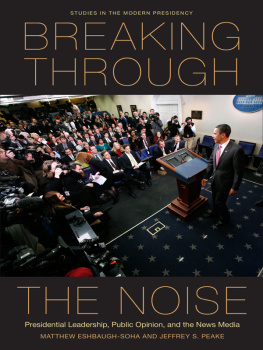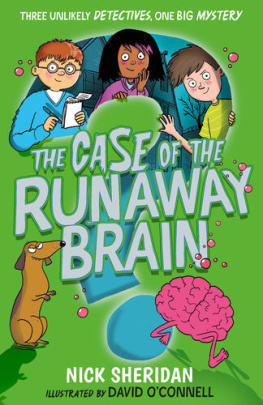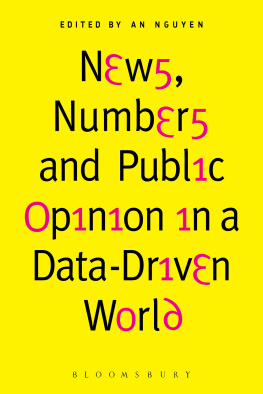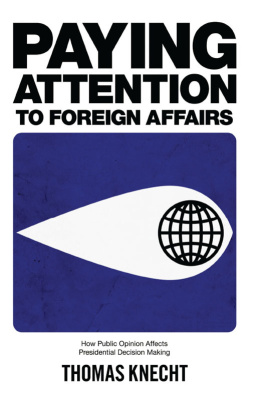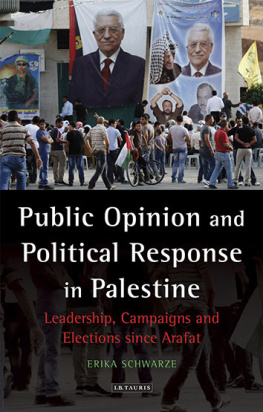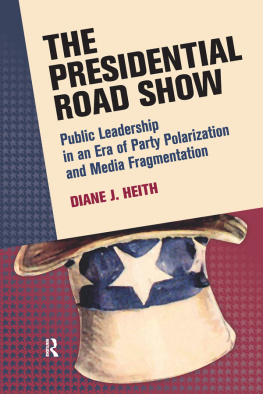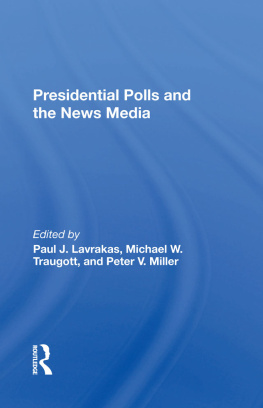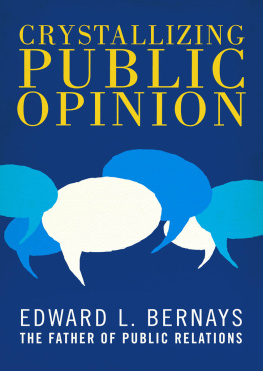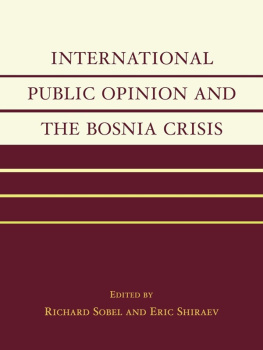Stanford University Press
Stanford, California
2011 by the Board of Trustees of the Leland Stanford Junior University. All rights reserved.
No part of this book may be reproduced or transmitted in any form or by any means, electronic or mechanical, including photocopying and recording, or in any information storage or retrieval system without the prior written permission of Stanford University Press.
Printed in the United States of America on acid-free, archival-quality paper
Library of Congress Cataloging-in-Publication Data
Eshbaugh-Soha, Matthew, 1972 author.
Breaking through the noise : presidential leadership, public opinion,
and the news media / Matthew Eshbaugh-Soha and Jeffrey S. Peake.
pages cm.(Studies in the modern presidency)
Includes bibliographical references and index.
ISBN 978-0-8047-7705-6 (cloth : alk. paper)
ISBN 978-0-8047-7706-3 (pbk. : alk. paper)
1. PresidentsUnited States. 2. PresidentsPress coverageUnited States. 3. Government and the pressUnited States. 4. Press and politicsUnited States. 5. Communication in politicsUnited States. 6. Public relations and politicsUnited States. 7. Political leadershipUnited States. 8. Public opinionUnited States. I. Peake, Jeffrey S., 1970 author. II. Title. III. Series: Studies in the modern presidency.
JK554.E73 2011
352.2360973dc22
2011017095
Typeset by Thompson Type in 10/15 Sabon
E-book ISBN: 978-0-8047-7821-3
BREAKING
THROUGH THE
NOISE
PRESIDENTIAL LEADERSHIP, PUBLIC
OPINION, AND THE NEWS MEDIA
Matthew Eshbaugh-Soha and
Jeffrey S. Peake
BREAKING THROUGH THE NOISE
STUDIES IN THE MODERN PRESIDENCY
A series edited by Shirley Anne Warshaw
Studies in the Modern Presidency is an innovative new book series that brings together established and emerging voices in modern presidential research, from the Nixon administration to the present. While works on the modern Congress abound, this series seeks to expand the literature available on the presidency and the executive branch.
Scholars and journalists alike are increasingly writing and reporting on issues such as presidential rhetoric, executive-legislative relations, executive privilege, signing statements, and so on. We are committed to publishing outstanding research and analysis that reaches beyond conventional approaches to provide scholars, students, and the general public with insightful investigations into presidential politics and power.
This series will feature short and incisive books that chart new territory, offer a range of perspectives, and frame the intellectual debate on the modern presidency.
A list of the books in this series can be found online at
http://www.sup.org/modernpresidency.
For my parents, Joe and Susan Soha
Matthew Eshbaugh-Soha
For Jacob and Nathan
Jeffrey S. Peake
Acknowledgments
Breaking through the Noise is the culmination of a lengthy collaboration that we began in 2002. Although we have written several conference papers and published a few articles on the presidency and media, we had avoided tackling the more difficult questions surrounding presidential leadership and responsiveness in regards to the public. Once we refined our ambitions to presidential agenda-setting and realized that we needed more than a couple of articles to make our mark, we turned our ideas into this book. We have arrived at the end of this project, not without a few bumps in the road, but as better scholars for having taken the journey.
Along the way, we have had help from many scholars and graduate students. George Edwardss research and guidance has been instrumental not only in this book but also in our general approach to studying the presidency. Jeff Cohen commented on our initial idea and was instrumental in helping us focus our research question. Dan Woods methodological approach to study the dynamics of the American presidency has clearly inspired this book. It is the ideas of these three giants in the subfield of presidential politics that drove much of this books research.
Others deserve thanks for helping, in both large and small ways, our ideas become this book. Matts colleagues at the University of North Texas were both patient and supportive. To name a few, Paul Collins answered myriad questions about methods, case selection, and theoretical framing, Tetsuya Matsubayashi helped explore other possible causal modeling strategies, Mathieu Turgeon commented on our conception of public opinion processing, and Jim Meernik, when department chair, fostered an environment conducive to writing a book. Thanks also to the Office of Research and Economic Development at the University of North Texas for a small grant that we used to help defray the cost of indexing the book. Jeffs colleagues at Bowling Green were great sounding boards for ideas. Especially helpful were David Jackson, Neal Jesse, and Melissa Miller. We thank . Several suggestions by two anonymous reviewers were vital to improving the presentation of the book and addressing limitations to our findings and conclusions according to the policies we examine. Thanks go as well to John Woolley and Gerhard Peters for the American Presidency Project, an indispensible resource for public presidency research.
Everyone at Stanford University Press has been helpful. Series editor Shirley Anne Warshaw provided encouragement and important suggestions at the initial stages of the project. Stacy Wagner saw enough promise in our proposal to send it out for review. She has offered valuable suggestions reflected in a much improved final manuscript. We appreciate that Jessica Walsh kept us apprised of our manuscript status during review and assisted us with completing the publication paperwork. Emily Smith and the production team at the Press were outstanding to work with. Finally, Margaret Pinettes help was instrumental in putting the final touches on the book.
Our deepest and most sincere thanks go to our families. Although Ethan and Rowans control of the Force has surely helped push this book to fruition, and Shelly provides essential inspiration, Matt dedicates this book to his parents, Joe and Susan Soha, for teaching him the importance of education and giving him the freedom to pursue his own path. Jacob and Nathan forced Jeff to devote at least some of his free time to play, rather than work, and Loris patience, strength, and love provided him much needed encouragement.
BREAKING THROUGH THE NOISE
CHAPTER 1
Introduction
CALLED THE GREAT COMMUNICATOR for his remarkable oratorical skill, President Ronald Reagan purportedly could sway the public to support him, using television to engage, motivate, and inspire the viewing audience. Despite this conventional understanding of presidential leadership that pervades Washington, D.C., systematic evidence of effective presidential leadership of the public proves illusive, even for the great communicator (Edwards 2003). In this book we are guided by the following puzzle: Why has presidential leadership of the public been unimpressive, even as the presidency retains substantial institutional tools to lead the public and news media?
The importance of this question is illustrated with two examples from both Reagan and Obama who, despite being perceived as powerful orators by their contemporaries, struggled in their efforts to lead the public. One of President Reagans top policy priorities concerned relations with Central America. Reagans public relations strategy centered on convincing the American people that the communist threat in Central America was real and that adequately funding the Nicaraguan Contras, an anti-communist guerilla force, was the best strategy to confront it. Reagan raised the issue many times with the American people, as he sought congressional support to fund the Contras who opposed the communist Sandinista government of Nicaragua. President Reagan spoke on aid to the Contras in twenty-five speeches in 1985 and thirty speeches in 1986, the peak of his attention to the issue (Edwards 2003, 132). In addition to mentioning the issue regularly in his public statements, Reagan delivered eight nationally televised addresses on Nicaragua and the Contras during his presidency (Edwards 2003, 3031), with four of these occurring before the disclosure of the Iran-Contra scandal in 1986.


